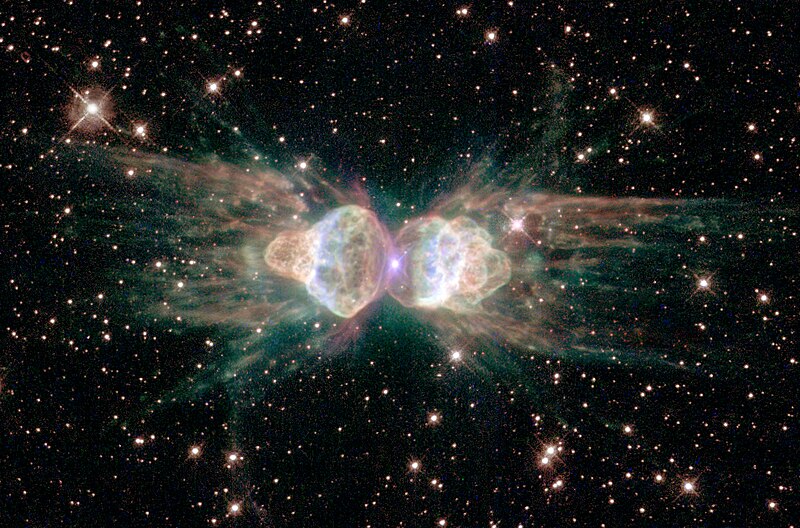Ofbeeldienge:Ant Nebula.jpg
Uiterlijk

Grootte van deze voorvertoning: 800 × 528 pixels. Andere resoluties: 320 × 211 pixels | 640 × 423 pixels | 1.072 × 708 pixels.
Ofbeeldienge in een ôgere resolutie (1.072 × 708 pixels, bestandsgrootte: 1,14 MB, MIME-type: image/jpeg)
Bestandsgeschiedenisse
Klik op een datum/tijd om het bestand te zien zoals het destijds was.
| Datum/tijd | Miniatuur | Afmetingen | Gebruiker | Opmerking | |
|---|---|---|---|---|---|
| huidige versie | 1 feb 2008 01:04 |  | 1.072 × 708 (1,14 MB) | Papa November | Full res version from source |
| 1 feb 2008 01:01 |  | 1.072 × 708 (148 kB) | Papa November | Uploaded full resolution image from source | |
| 29 jan 2008 14:30 |  | 600 × 362 (69 kB) | Nk | {{Information |Description=The Ant planetary nebula (Menzel 3 or Mz 3). STScI-PRC2001-05 This NASA/ESA Hubble Space Telescope image reveals the ant's body as a pair of fiery lobes protruding from a dying, Sun-like star. Though approaching the violence o |
Bloadn met dizze ofbeeldienge
Der is/zyn verwyzieng(e)n noar dit bestand ip de volgende bloadn:
Globaal bestandsgebruik
De volgende andere wiki's gebruiken dit bestand:
- Gebruikt op af.wikipedia.org
- Gebruikt op an.wikipedia.org
- Gebruikt op ar.wikipedia.org
- Gebruikt op ar.wikiversity.org
- Gebruikt op arz.wikipedia.org
- Gebruikt op ast.wikipedia.org
- Gebruikt op ba.wikipedia.org
- Gebruikt op bg.wikipedia.org
- Gebruikt op bjn.wikipedia.org
- Gebruikt op bn.wikipedia.org
- Gebruikt op br.wikipedia.org
- Gebruikt op ca.wikipedia.org
- Gebruikt op cbk-zam.wikipedia.org
- Gebruikt op ce.wikipedia.org
- Gebruikt op cs.wikipedia.org
- Gebruikt op de.wikipedia.org
- Gebruikt op en.wikipedia.org
- Astronomy
- Norma (constellation)
- Talk:Outline of physical science
- Mz 3
- List of planetary nebulae
- Portal:Astronomy/Picture/May 2005
- Portal:Astronomy/Picture/August 2005
- Portal:Astronomy/Picture/17 May 2005
- Portal:Astronomy/Picture/10 August 2005
- Portal:Astronomy/Picture/Week 01 2006
- User:King Zebu
- User:Exoplanetaryscience/sandbox
- Gebruikt op en.wikinews.org
Globaal gebruik van dit bestand bekijken.


